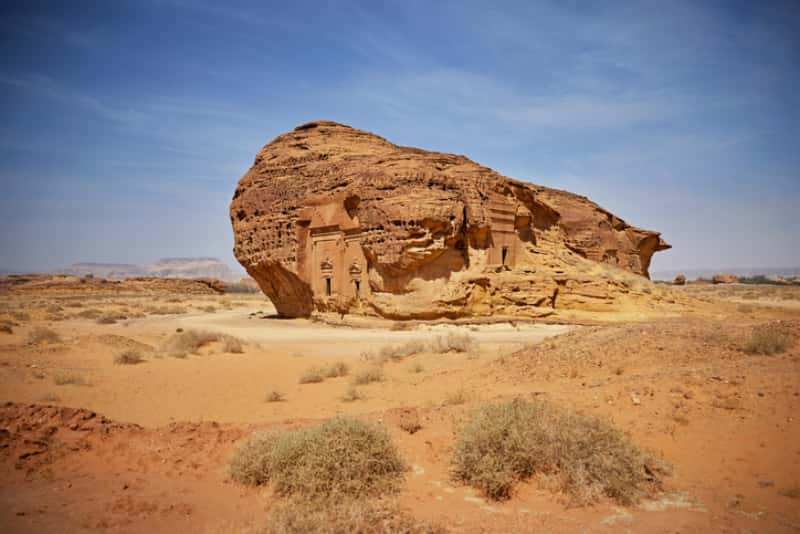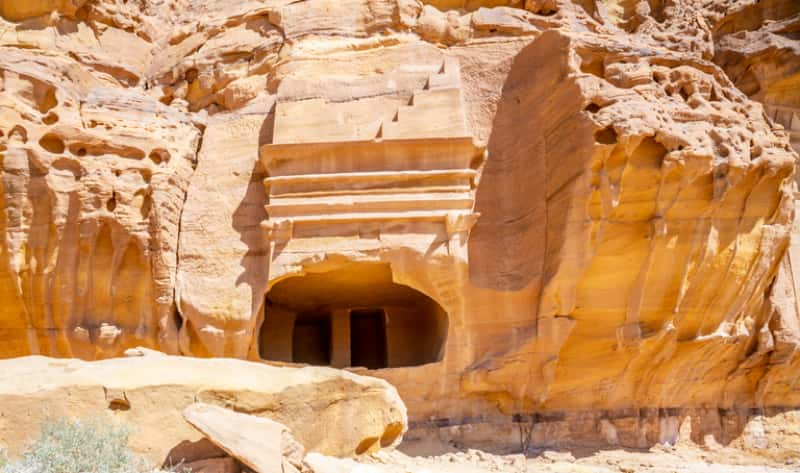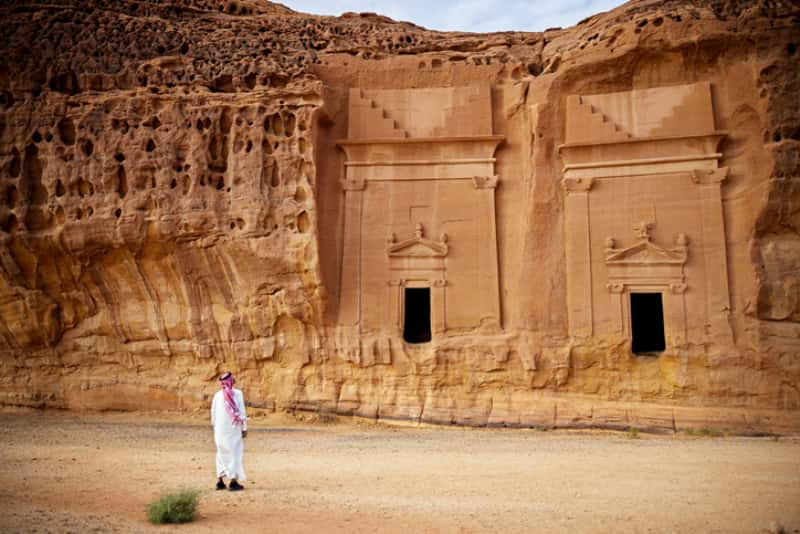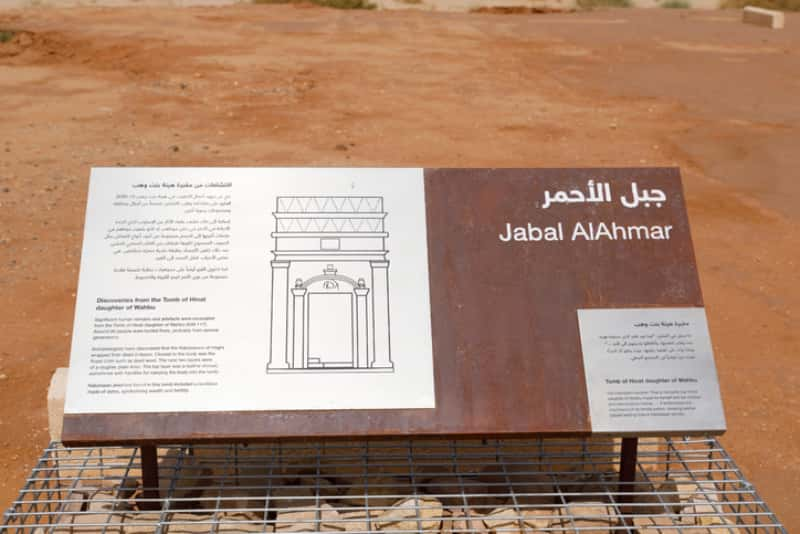Jabal Al-Ahmar rises from the Saudi Arabian landscape as a remarkable 2,000-year-old monument to Nabataean craftsmanship. These distinctive red sandstone cliffs cradle 18 exquisitely carved tombs, each bearing testament to ancient architectural brilliance. Visitors walking among these stone wonders encounter preservation quality that surpasses many comparable historical treasures worldwide.
The magnificent tombs form an integral component of the broader Hegra archaeological complex in AlUla. This exceptional site achieved prominence in 2008 when it became Saudi Arabia's first UNESCO World Heritage Site. Surrounding Jabal Al-Ahmar, the Hegra necropolis showcases over 100 monumental tombs carved between the 1st century BCE and 1st century CE—the golden age when Nabataean civilization mastered the art of rock-cut architecture. Archaeological experts frequently note that these tombs maintain superior condition compared to their more celebrated counterparts at Petra, Jordan. Travelers wishing to witness this ancient splendor should schedule their explorations during the clement weather period spanning October through April, when desert conditions prove most hospitable for appreciating these extraordinary monuments.
Jabal Al-Ahmar's striking red sandstone formations bear silent witness to the magnificent Nabataean cultural heritage. This archaeological treasure constitutes a cornerstone of Hegra, the southernmost major city within the once-prosperous Nabataean realm. Beyond its visual magnificence, Jabal Al-Ahmar harbors historical significance that runs deeper than mere aesthetic appeal.
Desert-dwelling nomads evolved into consummate merchants as the Nabataeans dominated regional commerce between the 4th century BC and 1st century AD. Their commercial prowess led them to establish Hegra as their second most significant urban center, subordinate only to their capital at Petra. Archaeological investigations reveal Hegra's particular flourishing from the first century BC, when it surpassed neighboring Dadan as the region's commercial focal point.
The genius of Nabataean achievement lies in their remarkable desert adaptation strategies. Water management mastery manifested in approximately 130 wells constructed throughout Hegra, enabling sustainable habitation and agriculture amid harsh conditions. Their architectural brilliance extended to ingenious natural water conduits integrated with carved structures, a feature that substantially contributing to the exceptional preservation witnessed today.
Jabal Al-Ahmar and the greater Hegra complex occupied prime real estate at commercial crossroads. Nabataean merchants essentially monopolized the profitable exchange of incense, myrrh, and spices. The site regularly welcomed camel caravans carrying precious cargo—peppercorn, ginger, sugar, and cotton moved through this bustling provincial hub.
The location functioned as a crucial junction linking trade pathways from southern Arabia to Egypt, Syria, the Mediterranean basin, and Mesopotamia. Such strategic positioning transformed the Nabataeans into wealthy intermediaries within an extensive commercial web spanning numerous civilizations. Hegra's connection to the Red Sea port of Egra Kome further enhanced its significance as a vital staging post along the principal north-south trade artery.
July 2008 marked a watershed moment when Jabal Al-Ahmar, as an integral component of the broader Hegra complex, secured recognition as Saudi Arabia's first UNESCO World Heritage Site. The official registration journey began in 2001, progressing through careful evaluation by a ministerial committee studying the site's historical importance.
UNESCO's prestigious designation acknowledged Hegra's exceptional value across multiple dimensions:
Though Roman imperial expansion gradually absorbed Nabataean culture by 106 AD, their architectural and cultural imprint endures at Jabal Al-Ahmar. UNESCO recognition has amplified tourism and global awareness of this previously overlooked civilization, allowing travelers to marvel at the accomplishments of these ancient master craftsmen of Arabia.

The distinctive red sandstone of Jabal Al-Ahmar harbors archaeological treasures that continuously illuminate our understanding of Nabataean civilization. Excavations across this sandstone canvas progressively unveil evidence of sophisticated burial practices and architectural mastery developed two millennia ago.
Jabal Al-Ahmar—whose name translates to "Red Mountain"—houses 18 precisely carved tombs distributed between two rocky massifs. These burial chambers rank among the oldest in the Hegra necropolis, providing scholars with crucial insights into Nabataean funerary customs. The mountain earned its vibrant title from its ruddy coloration, which regional folklore associates with a particular variety of red tulip. Visitors traversing the site observe how Nabataean artisans strategically positioned each tomb along the cliff face, showcasing their unparalleled ability to transform natural landscapes into sacred monuments.
Tomb IGN 117 emerges as particularly significant among these ancient structures. Unearthed in 2008 during collaborative French-Saudi archaeological work, this chamber bears an informative inscription reading: "This is the tomb which Hinat, daughter of Wahbu, made for herself and her children and her descendants forever." The text continues with clear ownership boundaries: "No one has the right to sell it or give it in pledge or write for this tomb a lease." Dating approximately to 60 CE, during "the twenty-first year of King Maliku, King of the Nabataeans," this inscription grants us rare personal insight into individual Nabataean life and societal structures.
The façades adorning Jabal Al-Ahmar's tombs display a sophisticated blend of Hellenistic and indigenous architectural traditions. Entrance designs incorporate classical elements—columns, capitals, pediments, and cornices—that have defied centuries of desert exposure. Protective symbols including eagles and sphinxes guard many thresholds, serving as spiritual sentinels for the deceased. Tomb IGN 120 stands as particularly noteworthy, featuring two parallel rows of merlons positioned above its inscription, exemplifying the refined decorative techniques that distinguished Nabataean craftsmen.
Among the most significant modern discoveries lies within Hinat's untouched tomb. While most Hegra burial chambers suffered historical intrusion, drifting desert sands concealed this entrance for centuries, leaving two original stone door slabs perfectly preserved. Meticulous excavation seasons yielded remains of approximately 80 individuals—presumably Hinat herself, alongside family members and descendants spanning generations. Researchers documented elaborate burial protocols, including bodies wrapped in plain-weave fabric layers with leather exterior coverings, preserved through applications of vegetable oil and resin. Curiously, several individuals wore necklaces fashioned from mature date stones, offering unprecedented glimpses into the material culture and burial rituals practiced by this ancient Arabian civilization.

Jabal Al Ahmar's mesmerizing crimson landscape narrates a geological saga spanning nearly half a billion years. These vibrant formations provided Nabataean artisans with an ideal canvas for their masterworks, whose exceptional preservation owes much to the distinctive properties of the surrounding terrain.
The magnificent rust-red hues characterizing Jabal Al Ahmar ("Red Mountain") originate primarily from rich iron oxide deposits permeating the sandstone. This natural pigmentation produces a captivating visual effect, particularly during dawn and dusk when sunlight appears to illuminate the rock formations from within. Geological records date these sandstone structures to the Cambrian period, exceeding 485 million years in age. These ancient stone chronicles function simultaneously as breathtaking visual spectacles and scientific archives documenting Earth's primordial history.
Jabal Al Ahmar consists of two separate massifs, each displaying distinctive geological attributes. Steep gradients and rugged surfaces challenge explorers while rewarding them with unparalleled vistas. The wider AlUla landscape represents a remarkable geological anomaly—three distinct geological epochs compressed into a single region. Countless millennia of persistent wind and water erosion have sculpted the malleable, porous sandstone into dramatic configurations, establishing a natural gallery of forms without equal elsewhere. Beyond its aesthetic qualities, this permeable rock structure serves an essential practical function as an aquifer, storing vital freshwater supplies that enabled human habitation within this parched environment.
Despite punishing desert conditions, the territories surrounding Jabal Al Ahmar harbor a remarkable array of plant species adapted to extreme temperature fluctuations and scarce rainfall. Weather patterns bring cyclonic storms predominantly from southwestern directions, with precipitation concentrated during winter and spring months when evaporation rates decrease. These climatic conditions foster distinctive desert vegetation, including various grasses, herbs, and shrubs that have developed specialized adaptive mechanisms for thriving in this challenging ecosystem. The striking contrast between fiery red sandstone formations and scattered verdant patches creates a compelling visual juxtaposition that further enhances the site's natural splendor.

Journeying to ancient Jabal Al-Ahmar demands thoughtful preparation to absorb its historical magnificence fully. Strategic planning unlocks the true splendor of this archaeological marvel nestled within AlUla's captivating landscape.
Jabal Al-Ahmar welcomes visitors as part of the expansive Hegra complex, with several straightforward access routes from AlUla town. Vehicle rental provides unmatched independence for thorough exploration of the region's treasures. Those preferring guided experiences may join organized tours or secure transportation through numerous local travel agencies. The Winter Park Visitor Center is the primary departure point for Hegra excursions, strategically positioned outside AlUla town. Scheduled buses depart precisely 45 minutes before reserved tour times. Winter Park offers complimentary parking facilities, a necessary convenience as direct vehicular access to heritage sites remains prohibited for preservation purposes.
The desert climate dictates optimal visitation periods, with October through April offering hospitable conditions for exploration. Spring months unfold particular magic across the landscape as wildflowers punctuate the terrain with unexpected bursts of color against the russet backdrop. Photographers and aesthetes alike treasure early morning and late afternoon hours when slanting sunlight bathes the red sandstone in golden illumination, highlighting intricate carved details otherwise hidden in midday glare. Prudent travelers avoid summer expeditions (May-September) when punishing heat renders exploration both challenging and potentially hazardous.
What to pack and prepare for
Essential equipment for Jabal Al-Ahmar exploration includes:
Jabal Al-Ahmar exists within a constellation of remarkable sites demanding attention. The greater Hegra archaeological complex showcases over 110 exquisitely preserved Nabataean tombs amid breathtaking natural rock formations. The recently established Hegra Welcome Center presents an immersive exhibition commemorating fifteen years since UNESCO World Heritage designation. Ambitious explorers should ascend to Harrat Viewpoint, where panoramic vistas reveal AlUla's otherworldly terrain stretching toward distant horizons. Equally significant, Jabal Ithlib stands as another sacred Nabataean site featuring the rock-hewn Diwan hall, once a gathering place for ancient nobility and religious ceremonies.
Jabal Al-Ahmar represents one of Saudi Arabia's most extraordinary archaeological jewels. This "Red Mountain" has stood sentinel across millennia, preserving the Nabataean legacy within its silent stone corridors. The 18 tombs meticulously carved into these crimson sandstone cliffs offer unparalleled insights into ancient architectural mastery and cultural practices. Archaeological examination confirms these structures surpass their more famous counterparts at Petra in preservation quality, despite receiving less global recognition.
The mountain presents visitors with a multifaceted experience spanning history and geology alike. Historically significant inscriptions, particularly those found in Hinat's tomb, provide rare personal connections to individuals who lived nearly two millennia ago. The geological formations themselves tell an even older story, shaped through natural forces across 485 million years. This strategic location along bustling ancient trade routes explains why Nabataean merchants selected this site as crucial to their commercial and cultural development.
Visitors planning their journey should note the pronounced seasonal variations affecting the area. The October through April window presents optimal conditions for exploration, with early morning and late afternoon hours offering the most spectacular lighting conditions as sunlight plays across the red sandstone surfaces. Jabal Al-Ahmar deserves focused attention, though the broader AlUla region surrounds it with complementary attractions. Together, these sites narrate the remarkable story of a civilization that not only survived but flourished amid challenging desert conditions thousands of years ago.
Q1. What makes Jabal Al-Ahmar unique among ancient sites?
Jabal Al-Ahmar is renowned for its 18 intricately carved Nabataean tombs, which are exceptionally well-preserved. The site's red sandstone cliffs and strategic location on ancient trade routes make it a significant archeological treasure.
Q2. When is the best time to visit Jabal Al-Ahmar?
The ideal time to visit is between October and April, when temperatures are milder. Early morning or late afternoon visits are recommended to witness stunning sunrises or sunsets that enhance the beauty of the red rocks.
Q3. What can visitors expect to see at Jabal Al-Ahmar?
Visitors can explore 18 Nabataean tombs carved into red sandstone cliffs, including the famous Hinat's tomb with its ancient inscription. The site also offers breathtaking geological formations and insights into Nabataean architecture and burial practices.
Q4. How does Jabal Al-Ahmar compare to Petra in Jordan?
While less famous than Petra, the tombs at Jabal Al-Ahmar are considered to be in better condition. The site provides a unique opportunity to experience well-preserved Nabataean architecture and cultural heritage.
Q5. What should I pack for a visit to Jabal Al-Ahmar?
Essential items include sturdy hiking boots, sun protection (hat and high-SPF sunscreen), plenty of water, and camera equipment. It's important to prepare for the desert climate and uneven terrain.
Uncover the mysteries of Jabal Al-Ahmar and its ancient Nabataean tombs. Experience this incredible UNESCO site firsthand. Plan your Saudi trips to AlUla and explore history that comes alive!

Find Related Tours


© Copyright 2024 Go Saudi Arabia Trips. All Rights Reserved.